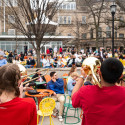From his perch, campus planner sees all
  Top: Robert Hendricks, the university’s assistant director for planning, for 33 years has played a key role in shaping the campus. Bottom: This 1993 aerial view of campus is missing some now-familiar landmarks, including the Genetics Biotechnology Center and Biochemistry Building. A flurry of construction and renovation during the past few years has changed the face of the campus. Photos: Jeff Miller. Top: Robert Hendricks, the university’s assistant director for planning, for 33 years has played a key role in shaping the campus. Bottom: This 1993 aerial view of campus is missing some now-familiar landmarks, including the Genetics Biotechnology Center and Biochemistry Building. A flurry of construction and renovation during the past few years has changed the face of the campus. Photos: Jeff Miller.
|
From his office on the eighth floor of the Wisconsin Alumni Research Foundation building, Robert Hendricks has an envious view.
As Lake Mendota sparkles in the morning sunlight, Picnic Point elegantly juts out into the blue-green water. The nearby athletic fields and the trees along the lake and the Howard Temin Lakeshore Path glisten with hues of deep green. The UW Band practices below, its music wafting into the air and up to Hendricks’ office.
“Every day, I look out and see different shades of green until fall comes,” Hendricks says. “Then winter comes, and I see different shades of white with the snow and water and ice. It’s an ever-changing view.”
And an appropriate one for Hendricks, the university’s assistant director for planning. For 33 years, Hendricks has played a key role in shaping the ever-changing landscape of the campus.
“I’ve always been interested in maps, development, the ways that things took place,” he says.
Like many long-time university employees, Hendricks ventured to Madison as a student and never left. After finishing his undergraduate degree in geography in 1965, Hendricks enrolled in the graduate program in urban and regional planning, and worked part time in the former Department of Planning and Construction. He accepted a full-time position in the department, now called Facilities Planning and Management, in 1967.
The student body numbered 20,118 when Hendricks transferred to UW–Madison from Carroll College in 1961. Since then, the student population has doubled, requiring more classrooms, laboratories, residence halls and other facilities to serve them.
Hendricks has been instrumental in helping to develop and manage that necessary growth, getting involved in the intimate details of physical planning while keeping an eye on the big picture. His tenure on campus is a case study in the maturation of urban planning as it relates to a large, research-oriented university located in a metropolitan setting.
Until the early 1970s, the university was not subject to municipal zoning ordinances and consulted on an as-needed basis with the city of Madison, village of Shorewood Hills and adjacent neighborhoods when pursuing construction projects. Now, UW–Madison works closely with municipal planners and neighborhood groups as it plans its projects.
“We try to spend a great deal of time working with our neighbors and municipal governments to make sure that what we are doing is compatible with what they are thinking and doing,” Hendricks says.
Currently, the campus is experiencing a boom in construction, in particular to keep up with expanding areas of knowledge in the health sciences and biotechnology. With that construction comes the related and just-as-important issues of transportation and parking.
Guiding it all is the Campus Master Plan, adopted in 1996 under Hendricks’ guidance. The master plan “is the epitome of the big picture,” he says, providing a flexible framework for the future development of the campus. Hendricks considers the Campus Master Plan the hallmark of his three-decade career.
“To be involved so intimately in a planning process of this scope is not something that comes along very often in this type of career,” he says.
As the band continues to practice outside his office, Hendricks attributes some of his inspiration for the job to the music below. “It actually energizes me,” he says.
As an undergrad, he played trombone for the UW Band and accompanied the team to the 1963 Rose Bowl.
Yet after more than three decades on the job, he admits his thoughts sometimes drift toward retirement at some point down the road. His wife, Margaret, recently retired from her job as a kindergarten teacher in Madison. And they have to keep up the gardens at their homes in Madison and Sister Bay in Door County.
Retirement for Hendricks will not only mean stepping away from campus planning; it will also mean giving up that great office view. “But I’ve got another pretty good view in Door County, too,” he says.



